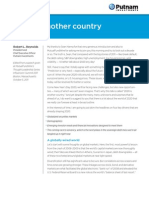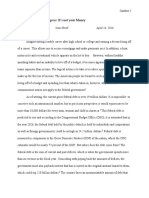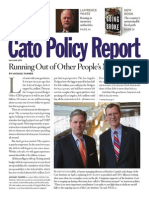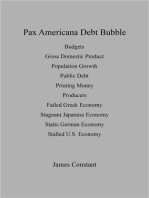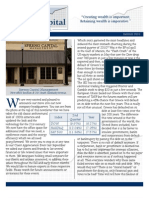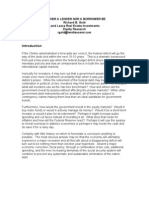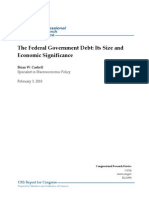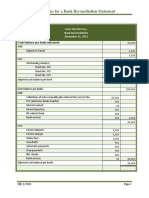Putnam Perspective: Reflections On National and Personal Solvency
Putnam Perspective: Reflections On National and Personal Solvency
Uploaded by
Putnam InvestmentsCopyright:
Available Formats
Putnam Perspective: Reflections On National and Personal Solvency
Putnam Perspective: Reflections On National and Personal Solvency
Uploaded by
Putnam InvestmentsOriginal Description:
Original Title
Copyright
Available Formats
Share this document
Did you find this document useful?
Is this content inappropriate?
Copyright:
Available Formats
Putnam Perspective: Reflections On National and Personal Solvency
Putnam Perspective: Reflections On National and Personal Solvency
Uploaded by
Putnam InvestmentsCopyright:
Available Formats
June 2011Putnam perspectives
Reflections on National and Personal Solvency
Robert L. Reynolds President and Chief Executive
Key takeaways
Our countrys pace of debt accumulation is both dangerous and unsustainable Substantial reforms must be made to entitlement programs before they drag down our economy We must transition to a new personal and government solvency based on higher savings and investment Private and public retirement savings programs both play key roles in the solution
As we can all see from this seasons intense debates in Washington, finding a way to restore our national solvency is the single most critical issue for our future. But even as we strive for fiscal sanity for our government, we should recognize that personal solvency, grounded on strong household balance sheets and retirement savings, is equally vital. National solvency and personal solvency complement each other. They are both key to rebooting economic growth and sustaining Americas future. A dangerous, unsustainable course Our country is at a critical inflection point. We really do face a choice between decline and renewal. The budget debates we read about and see on TV are not media hype. The stark truth is that were on a dangerous, unsustainable course one that could wreck the America we inherited. Failure is not an option. Nor are inaction, denial, or delay. Federal deficits already claim a far larger share of our economy than that of such peers in todays global economy as the United Kingdom, France, Canada, Australia, and Germany.
National solvency and personal solvency complement each other. They are both key to rebooting economic growth and sustaining Americas future.
Putnam Investments|putnam.com
June 2011|Reflections on National and Personal Solvency
Unless we change course, interest on our debt will quadruple by 2020 reaching nearly $800 billion a year.
Figure 1. Americas budget deficit is among the largest 2010 budget deficit as a percentage of GDP in some AAA-rated countries
U.S.
U.K.
France
Canada
Australia
Germany 3.3%
5.5% 7.0%
4.6%
10.6%
10.4%
Source: International Monetary Fund. Note: IMF calculations for the U.S. differ from Congressional Budget Office figures, which put the U.S. deficit at 8.9% GDP.
Our $14.3 trillion national debt is mind-boggling, difficult to even imagine. If we measured it in $100 bills, that debt would create a stack 9,000 miles high! And yet our national leadership in Washington seems unable to engage in serious bargaining to deal with the issue. Amid partisan positioning over the terms of extending our national debt ceiling, concern for our countrys credibility and solvency seems to be taking a back seat to the politics of the 2012 election. Meanwhile, the national debt is skyrocketing.
The Congressional Budget Office advises us that President Obamas recent budget would raise total national debt held by the public from roughly 63% of GDP today to more than 90% by 2020 with no end in sight! That is a debt-to economy ratio that America hasnt seen since World War II. And while this fiscal time bomb keeps ticking, interest costs on our debt are on track to explode.
Figure 2. Total national debt is on track to surpass GDP by 2020 U.S. federal debt as a percentage of GDP
(%) 200
148%
150
World War II 108.6% Over 90%
100
The Great Depression Vietnam War era Crash of 2008
50
22%
0 1930
1940
1950
1960
1970
1980
1990
2000
2010
2020E
2030E
Sources: Heritage Foundation compilations of data from U.S. Department of the Treasury, Institute for the Measurement of Worth (Alternative Fiscal Scenario), Congressional Budget Office, and White House Office of Management and Budget. 2
Putnam Investments|putnam.com
Figure 3. Interest on the debt alone will reach nearly $800 billion annually Inflation-adjusted dollars (2009)
800 600 ($Billions) 400 200 0 2000
Actual Projected
$768.2
$280.1
$186.9
2005
2010
2015
2020
Source: White House Office of Management and Budget, 2010 estimates.
Unless we change course, interest on our debt will quadruple by 2020 reaching nearly $800 billion a year. It is worth noting that this is happening at a time of historically low interest rates. That means that a sustained rise of just 1% in interest rates would add $150 billion more a year to this burden! Albert Einstein once described compound interest as the most powerful force in the universe, and we are gambling against it!
Whats worse, we now depend on foreign creditors to finance nearly half of our debt 47% nearly ten times as large as the 5% share they held in 1970! So far, most of our foreign creditors still believe that America can and will get its fiscal act together. That is the only reason why the U.S. Treasury can still borrow huge sums of money 10 years out at roughly 3.5%.
Figure 4. Other countries hold nearly half of our debt today Foreign holdings
5%
19%
47%
1970 Debt held by public: $283B
Source: U.S. Department of Treasury.
1990 Debt held by public: $2.4T
2010 Debt held by public: $8.4T
Americas dependence on foreign buyers at Treasury debt auctions makes us dangerously vulnerable to what former Presidential Chief of Staff Erskine Bowles has called the most predictable financial crisis in history.
3
June 2011|Reflections on National and Personal Solvency
Unless we see substantial reforms to Social Security, Medicare, and Medicaid, these three entitlement programs alone will grow by 2045 to absorb as much of Americas economy as the entire federal government budget has averaged since World War II.
But Americas dependence on foreign buyers at Treasury debt auctions makes us dangerously vulnerable to what former Presidential Chief of Staff Erskine Bowles has called the most predictable financial crisis in history. Should global investors conclude that our political leaders are unable or unwilling to deal with our deficits and debt, we could be plunged into crisis by surprise virtually overnight. In a real sense, then, America doesnt actually have a choice about coming to grips with its debts and bringing government spending under control. The real choice we face is whether to act ourselves or be acted on by some very ruthless global markets. Thats why it is a healthy sign that both parties, including President Obama and Republican leaders of Congress, are at least talking about how to cut our deficits and control our debt. We should all hope that talk turns into action, preferably in the current Congress, while America still has some maneuvering room. Time is not on our side. Delay only makes the policy actions needed to curb debt more painful and the risk of crisis worse. We must reform our entitlement programs The key driver of our deficits is simple. America is aging. Life expectancy is rising. Baby boomers are turning age 65 at the rate of about 7,000 a day. And over the next 20 years, the number of Americans over age 65 will nearly double from 40 million to 72 million. That is more people than all but a handful of member nations in the United Nations. The central impact of Americas aging is this: Unless we see substantial reforms to Social Security, Medicare, and Medicaid, these three entitlement programs alone will grow by 2045 to absorb as much of Americas economy as the entire federal government budget has averaged since World War II. So if we want government to pay for anything other than entitlements, whether that be the Marine Corps, Yellowstone Park, or the interest on our national debt, we will have to get serious about curbing entitlement costs and about raising some additional revenues to meet these demographically driven obligations. Both major political parties will have to make some painful concessions, which neither seems quite ready yet to do.
Figure 5. America is getting older Americans over age 65
40 million today
72 million by 2030
Source: U.S. Bureau of the Census, August 2008.
Putnam Investments|putnam.com
Figure 6. Entitlement programs are on track to reach 18% of GDP by 2045 Entitlements as percentage of GDP
Medicare Medicaid 15% Social Security 10%
18%
Average federal budget since WWII, as percentage of GDP
5%
0%
2005
2015E
2025E
2035E
2045E
Sources: GAO Sept. 2004 baseline extended analysis; Bruce Bartlett, Tax Reform Agenda for the 109th Congress 15 (2004). More recent data not available at the time of this presentation.
One thing that becomes very clear when you read the Standard & Poors report that recently downgraded Americas long-term debt prospects is that the real risk to our creditworthiness is not economic or financial. America has the economic resources to meet its obligations. The real risk is political paralysis, the seeming inability of our two-party system to find common ground, compromise, and make a transition that our country absolutely needs to make. Americas future economy simply has to be very different from the economic course we were on prior to the financial crisis of 20082009. We cannot go back to 2007 with a savings rate running near or below zero, debt-driven consumption as the economys main driver, our homes turned into ATM machines, and leverage rising everywhere. We need to transition to a new economic model based on higher savings, more investment, more opportunity for entrepreneurship, and private sector job creation a New Solvency, if you will.
In making that transition, action to strengthen Americas public and private retirement systems can and will play a vital role in reviving confidence and sustaining growth in our economy. It is important to understand how our two-stroke retirement engine has evolved before we turn to ways of strengthening it. Americas two-stroke retirement income engine Retirement income in America is drawn from two quite different sources human capital and financial capital. The main public retirement system, Social Security, is fueled by taxes on labor income (wages and salaries). Private retirement savings, mainly through workplace savings plans like the 401(k) or individual retirement accounts (IRAs), draw on financial earnings from profits, capital gains, dividends, and interest captured through stocks, bonds, and other investment securities.
We need to transition to a new economic model based on higher savings, more investment, more opportunity for entrepreneurship, and private sector job creation a New Solvency.
5
June 2011|Reflections on National and Personal Solvency
Figure 7. Human capital and financial capital Retirement income sources
$1,000 Cumulative percent change (in dollars) 800 600 400 200 0 -200 YTD FICA wage base S&P 500 Index
Both the public and private retirement systems need strengthening. Whats interesting to see illustrated here, though, is the way these systems complement each other. We use the FICA wage base to show the source of public retirement funds, i.e., from taxes on these wages, and use the S&P 500 Index as a proxy for long-term returns from U.S. equity markets. The green line shows how the FICA wage base, which funds Social Security, has been rising slowly but very steadily for decades. Over the 40 years since 1970, it is up by about 130% in real terms, with only minimal downturns during recessions. The red line shows the S&P 500 Index also in percentage terms. It has risen vastly more since 1970 by about 800% but with vastly more volatility including two ugly downturns in the past decade. This suggests that the United States has actually diversified its sources of retirement income fairly well, linking
flows from a steady, low-volatility source like wages to flows that come from faster-rising, but far more volatile, securities markets. To optimize results, we need to strengthen both sources. We must avoid over-burdening the workforce with any higher tax rates to support the public system not a wise policy when our highest priority has to be job creation. Yet we also need to increase revenues flowing into the system, most likely by raising the cap on the percentage of salaries subject to the FICA tax. On the private side, we must better enable all American workers to efficiently capture potentially high returns from securities markets while mitigating the risks we see here from frequently high volatility. This suggests the need to both extend coverage, through vehicles like auto-IRA payroll deduction, and build better ways of controlling volatility and reducing sequence-of-returns risk into workplace savings plan designs.
Recent research shows that workers in their 20s and 30s whose employers fully implement auto-pilot plan designs will be able to replace between 40% and 60% of their preretirement incomes just from their DC plans!
6
Putnam Investments|putnam.com
Congresss budget rules allow only a 10-year window to analyze the impact of tax deferrals. That methodology seriously overstates the costs to Treasury of savings tax deferrals and takes no account of future flow-backs when these assets are drawn on by retirees.
Figure 8. Today, America saves in workplace plans American workers covered
100 75 75 62 48 38 35 40 20 0 1980 1985 1990 1995 2000 2005 2008
Sources: Private Pension Plan Bulletin, Abstract of 2008 Form 5500 Reports, U.S. Department of Labor, December 2010. Collective Bargaining Status of Pension Plans, Total Participants by Type of Plan.
83
DC plans
(Millions)
50
38 39 40 42 42 42
DB plans
25
We have a strong savings base to build on The good news is that we have created a robust private workplace savings system, based mainly on 401(k) savings plans. These defined contribution (DC) plans now reach more than 83 million workers. And the DC system has proven itself to be strong, resilient, and always open to improvement. We also still have over 40 million people who enjoy defined benefit (DB) coverage, though that number is flat or falling except in the public sector. This suggests to me that if we can strengthen the DC system and extend its reach, we can take huge strides toward shoring up Americans belief in their own futures. And there is every reason to believe we can because the defined contribution 401(k) system has always been dynamic, not static. And with the passage of the Pension Protection Act of 2006, we transformed that system qualitatively, enabling 401(k) workplace savings to become Americas primary retirement system. The PPA endorsed three game-changing elements of defined contribution savings plan design: autoenrollment, savings escalation, and guidance to wise
7
asset allocation mainly age-appropriate lifecycle funds and balanced funds. The law also gave plan sponsors who adopted these best practices strong safe harbor legal protection. Today, the evidence on these policy innovations is in, and the good news is that we have essentially solved the challenge of accumulation. We have not fully implemented the solution. But we do know what works. Recent research shows that workers in their 20s and 30s whose employers fully implement auto-pilot plan designs will be able to replace between 40% and 60% of their preretirement incomes just from their DC plans! That is before you count Social Security, other savings, home equity, life insurance holdings, or any other assets they may have. In short, the best of todays post-PPA, auto-pilot workplace savings plans really do get the accumulation job done. So despite the awful impact of the 20082009 market crash, which slashed total workplace savings by nearly $1 trillion, the DC system is being revitalized. Most partic-
June 2011|Reflections on National and Personal Solvency
Whatever we do to curb federal deficits, we should never cut into incentives for personal or workplace savings. It would be a truly grotesque policy mistake to try to curb public deficits by undercutting tax deferrals for private savings.
Figure 9. Defined contribution plans have demonstrated resiliency Projected DC assets 19992015
($B) 6,000
5,000
4,000
3,000
2,000
1999 2000 2001 2002 2003 2004 2005 2006 2007 2008 2009 2010E 2011E 2012E 2013E 2014E 2015E
Source: FRC Monitor, September 2010.
ipants account balances have rebounded very strongly, and workplace savings are projected to grow by nearly 70%, to over $6 trillion, just in the next five years. Curbing savings plans is the wrong way to curb deficits Yet as all of us involved in retirement savings policy know, a terribly ironic new threat has cropped up. Precisely at the moment when we have finally figured out how to design workplace savings plans that can build up reliable lifetime nest eggs, just as we are recovering from the painful crash of 20089, we now face a new potential risk aimed right at the heart of retirement savings. It stems from well-intentioned, but misguided efforts to cut federal deficits. To understand this risk, you need to
see savings tax deferrals through a very bizarre lens, the one used by all too many budget hawks in Washington. Rightly concerned to curb deficits, these policymakers wrongly view the temporary tax forgiveness that retirement savers get for putting funds in an IRA, a 401(k), or variable annuities as tax expenditures. They forget that these assets will be taxed (and as ordinary income) the minute they are drawn on by retirees. This misreading is made possible because Congresss budget rules allow only a 10-year window to analyze the impact of tax deferrals. That methodology seriously overstates the costs to Treasury of savings tax deferrals and takes no account of future flow-backs when these assets are drawn on by retirees. A recent study conducted for the well-respected American Society of Pension Professionals and Actuaries (ASPPA) suggested
Capping or eliminating incentives for workplace and other retirement savings could have a devastating impact sending millions of low-and moderateincome workers toward retirement with essentially no savings. This is exactly the wrong direction for our country to consider moving in.
8
Putnam Investments|putnam.com
that this 10-year forward window for assessing savings deferrals costs to Treasury may overstate their true lifetime impact by between 55% and 77%. Making matters worse, budget hawks also have no way to take account of any dynamic benefits that savings may bring, through lower capital costs, for example. It is not surprising, then, that both of the recent deficit commissions proposed caps on the maximum amount of savings deferrals they would allow. One of the commissions proposed initially to sweep away all savings incentives, before backing off to suggest a cap of $20,000 a year or 20% of salary, whichever is lower. Such a limit may not seem very menacing. But once savings tax deferrals are on the table, then they are in play. The temptation to cut deeply into them is great. And that is exactly what happened in the last major tax code overhaul in 1986, when ceilings for 401(k) contributions were severely slashed and so many complications were imposed on IRAs that their growth was stymied for years. We do, of course, absolutely need to get deficits under control. But whatever we do to curb federal deficits, we should never cut into incentives for personal or workplace savings. It would be a truly grotesque policy mistake to try to curb public deficits by undercutting
tax deferrals for private savings by individuals and families to secure their own futures. After all, every dollar that retirement savers set aside is one less dollar that will ever be asked for as government aid in the future. Every company that offers a workplace savings plan is helping to meet a real national need. And the incentives for workplace savings do encourage employers, especially small businesses, to offer savings plans to low- and moderate-income workers not just to the owners and their key executives. Figure 10 shows the distribution of the tax deferrals for workplace savings by income level as well as the percentage of income taxes paid by individuals with those earnings. As you can see, 62% of these tax deferrals go to people earning less than $100,000 and 38% to those earning more than $100,000. But lets compare these tax deferrals to the federal taxes people actually pay. When we do that, we see that workers earnings less than $100,000 pay just 26% of federal income taxes but receive more than twice as large a share of tax deferrals 62% than the share of income taxes they actually pay. And while 38% of the tax deferrals go to those earning more than $100,000, these people pay fully three quarters of all federal income taxes. In other words, more affluent earners get only
Figure 10. The benefits of workplace plans accrue disproportionately to those who need them
(%) 60
52%
40 30%
32% 27% 18% 8% 11% 23%
20
0 Under $50,000 $50,000$100,000 $100,000$200,000 $200,000 or more
Participants with access and retirees with account balances Share of federal income taxes (after credits) paid
Source: American Society of Pension Professionals and Actuaries, 2011.
June 2011|Reflections on National and Personal Solvency
We need bipartisan action and compromise to deal with this and that is going to take guts.
Figure 11. People with access to workplace plans do save
(%) 80
71.5%
60
40
20
4.6%
0 With access to workplace plan Without workplace plan IRA only
Source: Employee Benefit Research Institute (2010) estimate using 2008 Panel of SIPP (covered by an employer plan) and EBRI estimate (not covered by an employer plan IRA only).
about half the share of savings tax breaks as they pay in taxes. A fair conclusion seems to me to be that the potential revenue gains to the Treasury from cutting tax deferrals is vastly overstated. But the damage such caps could inflict is vastly underestimated. That is because access to workplace savings is the prime determinant of whether low- and moderate-income workers save at all. Over 71% of workers earning between $30,000 and $50,000 do save for retirement, but only if they have access to payroll deduction savings plans at work. Among moderate-income workers who lack access to savings at work, fewer than 5% open tax-advantaged individual retirement accounts. This suggests that capping or eliminating incentives for workplace and other retirement savings could have a devastating impact sending millions of low- and moderate-income workers toward retirement with
essentially no savings. This is exactly the wrong direction for our country to move in. Instead of cutting savings incentives, we should be doing everything we can to expand workplace savings coverage for the many millions who lack it. One excellent way to do this would be the adoption of the auto-IRA payroll deduction proposal, a very reasonable, cost-effective idea that could draw many millions of lower-income workers into retirement savings and give them a stake in our freeenterprise system for the first time ever. The auto-IRA is a bipartisan idea developed jointly by the Heritage Foundation and the Brookings Institution. It links values that I believe should guide our policy choices in coming years, namely that national solvency and personal solvency go hand in hand. They complement each other. We should never pit one against the other. We need policies that foster both.
Real action to make Social Security solvent would be a huge confidence builder at home and around the world, proof positive that Americans can control our own destiny.
10
Putnam Investments|putnam.com
There really can be no doubt that the best way, the most American way to deal with our deficits and restore national solvency, is to fire up Americas job machine and get our economy growing faster than our debts.
Working toward a new solvency As we strive to restore fiscal sanity, the vital first step has to be recognizing that our deficits and debt are now dangerous enough to pose a genuine national security threat. We need bipartisan action and compromise to deal with this, and that is going to take guts, whether that be Democrats backing changes that slow the rise in entitlements, Republicans recognizing that we surely will need more tax revenues as the boomers age, or members of both parties coming together to create a pro-growth, pro-investment tax code. Those politicians and special interests who refuse to admit that we even face a serious fiscal problem or who say we dont need to make any serious changes in Social Security or Medicare are simply in denial. If their view wins, they will set America adrift, blindly, straight into a globally driven debt crisis and then into truly awful austerity, under ruthless market pressure, just as we are seeing happen in Greece. There are many elected officials and policymakers who are seeking good-faith, bipartisan solutions to curb federal spending and bring our deficits under control. In my view, these men and women are actually the truest defenders of the common safety net, the real leaders, pointing Americas way to fiscal stability and a shot at renewed prosperity. We can find them in both political parties. And we need a lot more of them! The single best first step we could take would be to reach a grand bargain to bring Social Security into long-term solvency. We can and should preserve the essence of Social Security and protect the truly needy. Social Security is a cornerstone element of most Americans retirement. It is absolutely vital to lower-income citizens who draw the vast majority of their retirement income from it. But the system is running a cash-flow deficit of nearly $50 billion this year, and it faces a multitrilliondollar long-term funding shortfall over the 75-year time frame its trustees are required to plan for. We need action to make it solvent, and the only better time to do that was yesterday! A viable Social Security deal would almost surely require Republicans to compromise on some measures to increase revenue. Democrats would have to concede that benefit increases will need to be slowed or means tested. It is important to note that what we are talking about here is a self-inflicted gap between the benefits that Congress has promised future retirees and the revenues it has voted for to pay for those promises. Closing this gap is really Congresss responsibility. With strong presidential leadership, that would be an eminently doable goal. I say that because it is an open secret in Washington that matching Social Securitys revenues to promised outflows for the next 70-plus years may be the easiest single element of Americas much larger solvency challenge. It requires arithmetic, not rocket science. It is infinitely easier than grappling with our medical entitlements, which face long-term shortfalls roughly 10 times larger. To be politically feasible, Social Security reform needs to meet three key criteria. First, we should not impact the benefits of any current retirees or those within 10 years of full retirement age. Second, we should not raise the basic payroll tax rate. That would discourage job creation just when we need it most. Third, we should sustain intact all future retirement benefits for lowincome Americans. All other paths to solvency should be open to discussion, including retirement ages, the percentage of income subject to FICA taxation, and benefits paid to middle-class and wealthy retirees whatever it takes. We actually know that these criteria can be met, because both of the recent budget commissions essentially did meet all three of them. It is true that the plans these commissions put forward would require some sacrifice by middle-class and wealthy recipients, but these sacri-
11
June 2011|Reflections on National and Personal Solvency
fices would mostly come in the form of smaller increases in some future benefits, not absolute cuts. It would even be possible, in fact, to not only secure, but actually increase benefits for the lowest-income retirees as part of a reform package. In other words, it is possible to craft a reform plan that would not only make Social Security solvent, but slightly more progressive, slightly more redistributive, and vastly more certain than the current system. Social Security solvency does not require draconian measures, just common sense and some very uncommon political courage in other words, leadership. Real action to make Social Security solvent would be a huge confidence builder at home and around the world, proof positive that Americans can control their own destiny. It would have major, positive benefits for the dollar, for national confidence, and perhaps even for mutual trust across our partisan divides. We should link a solvent Social Security system to reforms that strengthen and extend private workplace savings to reach virtually all working Americans, including the payroll deduction auto-IRA I mentioned earlier. Personal solvency, defined by solid savings rates, and a revitalized, expanded workplace savings system can help fuel stronger economic growth the single most vital element in any plan to reduce our future deficits.
President John F. Kennedy was right when he said that a rising tide lifts all boats. And policies to foster investment and business formation follow directly, even inevitably, on efforts to raise national savings. Why? Because we need to give these additional savings positive options for investing in Americas future. There really can be no doubt that the best way, the most American way to deal with our deficits and restore national solvency, is to fire up Americas job machine and get our economy growing faster than our debts. Like JFK, I am an optimist. You really have to be if you are lucky enough to live in this country. People risk their lives every day to come here. And they are right to want to. So as scary as our deficits are, as huge as our national debt may be, I know this for sure: America has dealt with much, much tougher challenges before. I am convinced we can meet this one. All we need is the will.
As scary as our deficits are, as huge as our national debt may be, I know this for sure: America has dealt with much, much tougher challenges before. I am convinced we can meet this one. All we need is the will.
The views and opinions expressed are those of Robert L. Reynolds, President and CEO of Putnam Investments, are subject to change with market conditions, and are not meant as investment advice. Based on remarks to the Greater Boston Chamber of Commerce Executive Forum, Boston, Massachusetts, May 24, 2011.
Putnam Retail Management | One Post Office Square | Boston, MA 02109 | putnam.com
2689346/11
You might also like
- CCVODocument2 pagesCCVOAlonzoNo ratings yet
- Independent Equity Research: How We Do It, and Why It Matters To InvestorsDocument12 pagesIndependent Equity Research: How We Do It, and Why It Matters To InvestorsPutnam InvestmentsNo ratings yet
- Week 1 Defining Marketing For The New RealitiesDocument21 pagesWeek 1 Defining Marketing For The New RealitiesDesi Fitri NasutionNo ratings yet
- Econ Chapter 6 Section 1Document3 pagesEcon Chapter 6 Section 1Abi CalderaleNo ratings yet
- GST Implementation Project Business Blueprint: Vcentric Technologies Private LTD April 2017Document67 pagesGST Implementation Project Business Blueprint: Vcentric Technologies Private LTD April 2017Deepak100% (1)
- The National Debt: A Look at The Past and The Present. The Good and The Bad. Macroeconomics E202-April 15, 2019Document11 pagesThe National Debt: A Look at The Past and The Present. The Good and The Bad. Macroeconomics E202-April 15, 2019Kylie Crawford100% (1)
- Hoisington 1 Quarter 2012Document13 pagesHoisington 1 Quarter 2012pick6No ratings yet
- Putnam: 2020 Is Another CountryDocument8 pagesPutnam: 2020 Is Another CountryPutnam InvestmentsNo ratings yet
- America CLDocument11 pagesAmerica CLkakeroteNo ratings yet
- China and the US Foreign Debt Crisis: Does China Own the USA?From EverandChina and the US Foreign Debt Crisis: Does China Own the USA?No ratings yet
- Our Government Has Run Out of MoneyDocument10 pagesOur Government Has Run Out of MoneykakeroteNo ratings yet
- Government Austerity Measures Next StepDocument10 pagesGovernment Austerity Measures Next StepkakeroteNo ratings yet
- Global Market Outlook July 2011Document8 pagesGlobal Market Outlook July 2011IceCap Asset ManagementNo ratings yet
- SubmittedeconpaperDocument7 pagesSubmittedeconpaperapi-207294683No ratings yet
- America in PerilDocument12 pagesAmerica in PerilkakeroteNo ratings yet
- Issue BriefDocument14 pagesIssue Briefapi-316754061No ratings yet
- Running Out of Other People's Money: It's The Entitlements, StupidDocument4 pagesRunning Out of Other People's Money: It's The Entitlements, StupidLatinos Ready To VoteNo ratings yet
- Government Austerity Measures Next StepDocument10 pagesGovernment Austerity Measures Next StepkakeroteNo ratings yet
- Reinventing Economic and Financial PolicyDocument10 pagesReinventing Economic and Financial PolicySFLDNo ratings yet
- Keithly Eportfolio BudgetdeficitDocument5 pagesKeithly Eportfolio Budgetdeficitapi-260497485No ratings yet
- America AlDocument12 pagesAmerica AlkakeroteNo ratings yet
- Discussion Around The Article Linked BelowDocument12 pagesDiscussion Around The Article Linked BelowAllan WortNo ratings yet
- Our Government Has Run Out of MoneyDocument10 pagesOur Government Has Run Out of MoneykakeroteNo ratings yet
- Why We Must End Too Big To FailDocument21 pagesWhy We Must End Too Big To FailBryan CastañedaNo ratings yet
- Research Paper Final - Fouad SalehDocument13 pagesResearch Paper Final - Fouad Salehapi-466403567No ratings yet
- Why Budget 2025 MattersDocument3 pagesWhy Budget 2025 Matterssudershannegi7013No ratings yet
- Senator Rand Paul: A Platform To Revitalize America (Updated)Document103 pagesSenator Rand Paul: A Platform To Revitalize America (Updated)Senator Rand PaulNo ratings yet
- Holtzeakin Testimony 4oct2011Document12 pagesHoltzeakin Testimony 4oct2011Committee For a Responsible Federal BudgetNo ratings yet
- Midtown-HaJa-Aff-4---Florida-Blue-Key-Speech-and-Debate-Tournament-Semis (1)Document18 pagesMidtown-HaJa-Aff-4---Florida-Blue-Key-Speech-and-Debate-Tournament-Semis (1)eeshaeesha.sheeshaNo ratings yet
- The Real World of Money and Taxation in AmericaDocument9 pagesThe Real World of Money and Taxation in AmericaPotomacOracleNo ratings yet
- Spreng Capital Outlook 2010 Q2Document4 pagesSpreng Capital Outlook 2010 Q2a1printingNo ratings yet
- How Debt Limits A Country's OptionDocument5 pagesHow Debt Limits A Country's Optionoptimistic07No ratings yet
- The National DebtDocument3 pagesThe National DebtSai MuttavarapuNo ratings yet
- Sprott 2013 P1 Ignoring The ObviousDocument7 pagesSprott 2013 P1 Ignoring The ObviouscasefortrilsNo ratings yet
- 2012: THE WEAK ECONOMY AND HOW TO DEAL WITH IT TO EMPOWER THE CITIZENSFrom Everand2012: THE WEAK ECONOMY AND HOW TO DEAL WITH IT TO EMPOWER THE CITIZENSNo ratings yet
- DC Cuts: How the Federal Budget Went from a Surplus to a Trillion Dollar Deficit in 10 YearsFrom EverandDC Cuts: How the Federal Budget Went from a Surplus to a Trillion Dollar Deficit in 10 YearsNo ratings yet
- Economic CrisisDocument2 pagesEconomic CrisisAayush KubbaNo ratings yet
- CA Newsletter July 28 To 03 AugDocument15 pagesCA Newsletter July 28 To 03 AugAshish DeshpandeNo ratings yet
- Meet The World's Largest Subprime DebtorDocument7 pagesMeet The World's Largest Subprime DebtoreliforuNo ratings yet
- The Road To PerditionDocument3 pagesThe Road To PerditionBrian BarkerNo ratings yet
- Neither A Lender Nor A Borrower Be Richard B. Gold Lend Lease Real Estate Investments Equity ResearchDocument8 pagesNeither A Lender Nor A Borrower Be Richard B. Gold Lend Lease Real Estate Investments Equity ResearchMichael CypriaNo ratings yet
- Saving The American DreamDocument53 pagesSaving The American DreamMichael ParrishNo ratings yet
- Do Deficits MatterDocument5 pagesDo Deficits MatterNicholas IordanisNo ratings yet
- Summary: Running On Empty: Review and Analysis of Peter G. Peterson's BookFrom EverandSummary: Running On Empty: Review and Analysis of Peter G. Peterson's BookNo ratings yet
- The Coming Collapse of America: How to Balance the Federal Budget: Second Edition 2023From EverandThe Coming Collapse of America: How to Balance the Federal Budget: Second Edition 2023Rating: 5 out of 5 stars5/5 (1)
- Into The Abyss: The Cycle of Debt DeflationDocument13 pagesInto The Abyss: The Cycle of Debt DeflationRon HeraNo ratings yet
- Budget Basics: National Press Foundation September 21, 2015 Sudeep Reddy - @reddyDocument24 pagesBudget Basics: National Press Foundation September 21, 2015 Sudeep Reddy - @reddyNational Press FoundationNo ratings yet
- Keynesian Economics Doesn't WorkDocument9 pagesKeynesian Economics Doesn't WorkkakeroteNo ratings yet
- Bob Chapman Spending Debt Which Is Other People S Money Further Recession and Financial Turmoil in America and The EU 1 10 2011Document4 pagesBob Chapman Spending Debt Which Is Other People S Money Further Recession and Financial Turmoil in America and The EU 1 10 2011sankaratNo ratings yet
- According To Napier 10 2022Document11 pagesAccording To Napier 10 2022Gustavo TapiaNo ratings yet
- Fiscal Space: Special ReportDocument19 pagesFiscal Space: Special ReportNgô Túc HòaNo ratings yet
- U.S. Government Debt: The Upward Spiral Continues: Olume EptemberDocument23 pagesU.S. Government Debt: The Upward Spiral Continues: Olume Eptemberrichardck50No ratings yet
- The Pessimist Complains About The Wind The Optimist Expects It To Change The Realist Adjusts The Sails.Document17 pagesThe Pessimist Complains About The Wind The Optimist Expects It To Change The Realist Adjusts The Sails.brundbakenNo ratings yet
- Federal DebtDocument14 pagesFederal Debtabhimehta90No ratings yet
- Educating Voters for Rebuilding America: National Goals and Balanced BudgetFrom EverandEducating Voters for Rebuilding America: National Goals and Balanced BudgetNo ratings yet
- 7-12-11 Too Big To FailDocument3 pages7-12-11 Too Big To FailThe Gold SpeculatorNo ratings yet
- 2012Q3 - Newsletter October 2012 - PDF Single PageDocument4 pages2012Q3 - Newsletter October 2012 - PDF Single PagePacifica Partners Capital ManagementNo ratings yet
- 09.07.12 JPM Fiscal Cliff White PaperDocument16 pages09.07.12 JPM Fiscal Cliff White PaperRishi ShahNo ratings yet
- The 2012 Index of Dependence On GovernmentDocument34 pagesThe 2012 Index of Dependence On Governmentaustintexas1234No ratings yet
- ESSAY1 - Divya VirmaniDocument10 pagesESSAY1 - Divya VirmanidvirmaniNo ratings yet
- Hudson, M. Scenarios For Recovery - How To Write Down The Debts and Restructure The Financial SystemDocument28 pagesHudson, M. Scenarios For Recovery - How To Write Down The Debts and Restructure The Financial SystemxdimitrisNo ratings yet
- Byron WienDocument3 pagesByron WienZerohedge100% (2)
- Putnam White Paper: The Outlook For U.S. and European BanksDocument12 pagesPutnam White Paper: The Outlook For U.S. and European BanksPutnam InvestmentsNo ratings yet
- Optimizing Your LinkedIn ProfileDocument2 pagesOptimizing Your LinkedIn ProfilePutnam Investments60% (5)
- Financial Advisors' Use of Social MediaDocument2 pagesFinancial Advisors' Use of Social MediaPutnam InvestmentsNo ratings yet
- Affluent Investors Use of Social MediaDocument2 pagesAffluent Investors Use of Social MediaPutnam InvestmentsNo ratings yet
- Muni Rally May Continue, But Must Navigate Policy RisksDocument3 pagesMuni Rally May Continue, But Must Navigate Policy RisksPutnam InvestmentsNo ratings yet
- Putnam Research Fund Q&A Q3 2012Document4 pagesPutnam Research Fund Q&A Q3 2012Putnam InvestmentsNo ratings yet
- Putnam Gifting Opportunities in 2012Document4 pagesPutnam Gifting Opportunities in 2012Putnam InvestmentsNo ratings yet
- Asset ProtectionDocument4 pagesAsset ProtectionPutnam Investments100% (1)
- Chapter15 - Capital Basel PDFDocument52 pagesChapter15 - Capital Basel PDFAmira GawadNo ratings yet
- Profit Maximization and Wealth MaximizationDocument16 pagesProfit Maximization and Wealth MaximizationOnindya MitraNo ratings yet
- 2023 - Project Management - Lecturenote - Business CaseDocument21 pages2023 - Project Management - Lecturenote - Business CaselequynhduongphuongNo ratings yet
- Delhi LBDocument1 pageDelhi LBSatkar Garment100% (1)
- UK Finance UK Payment Markets Report 2019 SUMMARYDocument8 pagesUK Finance UK Payment Markets Report 2019 SUMMARYRohitNo ratings yet
- DDWG 2523 Financial Accounting Ii: Chapter 1-Control AccountsDocument22 pagesDDWG 2523 Financial Accounting Ii: Chapter 1-Control AccountsAzyyati Mohamad UtamaNo ratings yet
- Pakistan Economy Era'sDocument14 pagesPakistan Economy Era'sIqra AkramNo ratings yet
- Does Australia's Health Insurance System Really Provide Insurance?Document9 pagesDoes Australia's Health Insurance System Really Provide Insurance?Core Research100% (1)
- Long Term StrategyDocument15 pagesLong Term Strategykim cheNo ratings yet
- Basic Instructions For A Bank Reconciliation Statement PDFDocument4 pagesBasic Instructions For A Bank Reconciliation Statement PDFAman KodwaniNo ratings yet
- Oct 2023Document2 pagesOct 2023info.adnankhan1995No ratings yet
- Tesla - Principle of StrategyDocument10 pagesTesla - Principle of StrategyTrâm TrươngNo ratings yet
- AR: Absolute Return + Alpha. Press Release. Billion Dollar Club & Hedge Fund Report CardDocument3 pagesAR: Absolute Return + Alpha. Press Release. Billion Dollar Club & Hedge Fund Report CardAbsolute ReturnNo ratings yet
- The e Commerce Revolution American English StudentDocument6 pagesThe e Commerce Revolution American English StudentVITÓRIA SANTOS RODRIGUES DA SILVANo ratings yet
- Suryapunja Saving & Credit Co-Operative LTD.: Group Balance Sheet As On 2074/03/31 (Details)Document2 pagesSuryapunja Saving & Credit Co-Operative LTD.: Group Balance Sheet As On 2074/03/31 (Details)BimalNo ratings yet
- Practical Accounting TwoDocument25 pagesPractical Accounting TwoJoseph SalidoNo ratings yet
- Takaful MyClick Motor PDSDocument4 pagesTakaful MyClick Motor PDSzahrinNo ratings yet
- Does Quality Management Work in Public SectorDocument30 pagesDoes Quality Management Work in Public Sectorintan_2410No ratings yet
- Myntra SWOT AnalysisDocument8 pagesMyntra SWOT AnalysisAkhil k Santy50% (4)
- Study Material CH.-1 Fundamentals of Partnership 2023-24Document28 pagesStudy Material CH.-1 Fundamentals of Partnership 2023-24vsy9926No ratings yet
- 25-Samin Annual Report.11Document46 pages25-Samin Annual Report.11uzair237No ratings yet
- Pestel: What Is PESTEL Analysis?Document7 pagesPestel: What Is PESTEL Analysis?Sherwin Basan CelestialNo ratings yet
- The IB Business of Trading Prime BrokerageDocument78 pagesThe IB Business of Trading Prime BrokerageNgọc Phan Thị BíchNo ratings yet
- PRR 8729 Service Group 2 Part 2 PDFDocument62 pagesPRR 8729 Service Group 2 Part 2 PDFRecordTrac - City of OaklandNo ratings yet
- Shahid Iqbal S/O Allah-Rakha Sheraz Villaz Ph-2 W/RD LHR: Web Generated BillDocument1 pageShahid Iqbal S/O Allah-Rakha Sheraz Villaz Ph-2 W/RD LHR: Web Generated Billarsalan khanNo ratings yet
- Satish SharmaDocument9 pagesSatish SharmaIzmi AsyifaNo ratings yet







